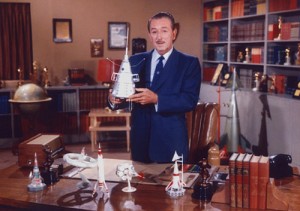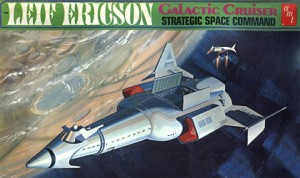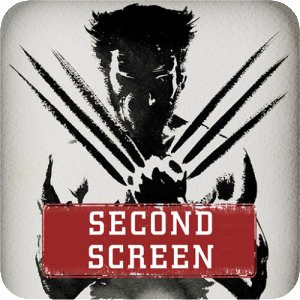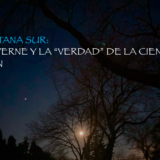 One big thing going for plastic modeling is that models of almost any subject can be manufactured so that the modeler can build and display those unique subjects he enjoys most. This is absolutely true for spaceships. Science fiction spaceships basically are creations of the imagination and you will almost never see one out on the street. So if you have a great interest in certain science fiction vehicles and would like to have one displayed on your shelves you can likely find a model of one to build. There are a great number of spaceship models available these days with more being introduced all the time.
One big thing going for plastic modeling is that models of almost any subject can be manufactured so that the modeler can build and display those unique subjects he enjoys most. This is absolutely true for spaceships. Science fiction spaceships basically are creations of the imagination and you will almost never see one out on the street. So if you have a great interest in certain science fiction vehicles and would like to have one displayed on your shelves you can likely find a model of one to build. There are a great number of spaceship models available these days with more being introduced all the time.
 From my research it appears that some of the first spaceship models were introduced in the mid-1950s. Strombecker was a company that had been in business since the 1930s producing wood models at that time. When injected molded plastics became available the company started producing plastic models of airplanes and other vehicles. In 1957 Walt Disney had become very interested in the new space program and contacted Wernher von Braun, the expatriated German rocket scientist, who was heading NASA’s Huntsville rocket center. Dr. von Braun had conceptualized a vision of the future with manned rockets and manned space stations and a series of articles were published in Collier’s magazine during the 1950s. The collaboration between the two resulted in the 1955 Disneyland TV episode, Man in Space. The show featured Dr. von Braun and other rocket scientists discussing von Braun’s vision of man’s future in space. Strombecker worked with Disney to create a line of kits based on von Braun’s ideas and the Disney show introduced some of the first spaceship model kits including the rocket to the moon in 1957.
From my research it appears that some of the first spaceship models were introduced in the mid-1950s. Strombecker was a company that had been in business since the 1930s producing wood models at that time. When injected molded plastics became available the company started producing plastic models of airplanes and other vehicles. In 1957 Walt Disney had become very interested in the new space program and contacted Wernher von Braun, the expatriated German rocket scientist, who was heading NASA’s Huntsville rocket center. Dr. von Braun had conceptualized a vision of the future with manned rockets and manned space stations and a series of articles were published in Collier’s magazine during the 1950s. The collaboration between the two resulted in the 1955 Disneyland TV episode, Man in Space. The show featured Dr. von Braun and other rocket scientists discussing von Braun’s vision of man’s future in space. Strombecker worked with Disney to create a line of kits based on von Braun’s ideas and the Disney show introduced some of the first spaceship model kits including the rocket to the moon in 1957.
 Strombecker produced a series of these kits at the time based on von Braun’s concepts. There were also a couple of other space model kits conceptualized by different scientists in the Strombecker line. The picture here shows some of these Strombecker kits from that era. The Disney show was quite popular and Disney actually edited it to play at the theaters in conjunction with their very popular Davy Crockett movie. The second picture shows Walt Disney at his desk with some of the kits on display. During the 1960s Strombecker would discontinue plastic model production and the molds and rights for the space series of kits would be purchased and produced by the Glencoe company. Some of these are still available at hobby outlets for those interested. I have most of them in my collection to build someday. They are very interesting early conceptualizations of spaceships by experts in the field.
Strombecker produced a series of these kits at the time based on von Braun’s concepts. There were also a couple of other space model kits conceptualized by different scientists in the Strombecker line. The picture here shows some of these Strombecker kits from that era. The Disney show was quite popular and Disney actually edited it to play at the theaters in conjunction with their very popular Davy Crockett movie. The second picture shows Walt Disney at his desk with some of the kits on display. During the 1960s Strombecker would discontinue plastic model production and the molds and rights for the space series of kits would be purchased and produced by the Glencoe company. Some of these are still available at hobby outlets for those interested. I have most of them in my collection to build someday. They are very interesting early conceptualizations of spaceships by experts in the field.



My research shows that after the release of these early spaceship models there were no new science fiction related  spaceship models released until later in the 1960s. Around 1966 AMT secured rights to produce the spaceship models from the Star Trek television series in exchange for assisting in making studio models for Paramount. The first two kits produced at that time were, obviously, the USS Enterprise in 1966 and also the Klingon D7 model in 1968. I remember owning both of these kits back in the day. Because the series was cancelled in 1969 after it had fallen out of popularity these were the only two kits they had introduced. But just a couple of years later a resurgence of interest manifested itself during syndication of the show and AMT started producing other ships from the show. These included the Romulan Bird-of-Prey, Mr. Spock, the Galileo shuttlecraft, Deep Space Station K-7, and the exploration set of tools. AMT would go on to produce numerous Star Trek kits far into the future as the Star Trek universe expanded. Here are a couple of examples of those early kits.
spaceship models released until later in the 1960s. Around 1966 AMT secured rights to produce the spaceship models from the Star Trek television series in exchange for assisting in making studio models for Paramount. The first two kits produced at that time were, obviously, the USS Enterprise in 1966 and also the Klingon D7 model in 1968. I remember owning both of these kits back in the day. Because the series was cancelled in 1969 after it had fallen out of popularity these were the only two kits they had introduced. But just a couple of years later a resurgence of interest manifested itself during syndication of the show and AMT started producing other ships from the show. These included the Romulan Bird-of-Prey, Mr. Spock, the Galileo shuttlecraft, Deep Space Station K-7, and the exploration set of tools. AMT would go on to produce numerous Star Trek kits far into the future as the Star Trek universe expanded. Here are a couple of examples of those early kits.
Not to be forgotten is the Aurora Plastics Corporation. They had secured rights to TV shows by Irwin Allen. Their first plastic kit of a science fiction subject was the SSRN Seaview from Voyage to the Bottom of the Sea released in 1965. While not exactly a spaceship it was very spacey and futuristic looking. The show also featured a flying sub and Aurora released a kit of this spacey craft in 1966. Aurora also released kits of the Spindrift from Irwin Allen’s Land of the Giants TV show and the Invaders UFO from the ABC TV show of the same name. Aurora obtained licensing rights to the classic science fiction movie, 2001: A Space Odyssey. This was the most realistic space movie probably ever produced and definitely far ahead of its’ time when released in 1968. I remember seeing it in Cinerama at a theater in Tampa, FL and was totally mesmerized by the realism as well as the extremely intelligent theme of the movie. Aurora ended up producing the Orion Pan-Am space clipper as well as the moon bus from the movie. I only owned the clipper during my youth but recently Moebius Models has released new versions of both of these kits and they now reside on my display shelves.


This fairly well was the extent of spaceship models introduced during the ‘50s and ‘60s. There was a lack of big hit science fiction TV shows or movies that involved iconic spaceships that the public could identify with. AMT did start producing more Star Trek models from the original series as the show went into syndication and its’ popularity grew during the ‘70s. These included the shuttlecraft Galileo from the Galileo 7 episode, the Romulan Bird-of-Prey, the Space Station K7 from the highly popular Trouble with Tribbles episode, and a spin-off original design from AMT, the Leif Ericson spacecraft. The Leif Ericson was supposed to be the first in a line of science fiction spaceships but ended up being the first and only of the planned series. Many of these kits were no longer produced after the ‘80s and would command a premium price at places like eBay but recently Round 2 has started producing them again under their original AMT label. Here are a couple of the boxes for these kits.
In December 1979 Paramount released the first Star Trek related movie some 10 years after the final TOS episode. This movie featured new ships, particularly the Enterprise, and AMT was ready immediately to start introducing new kits based on the movie. In 1979 AMT released the first two of these. One was the Vulcan Warp Shuttle which ferried Commander Spock from Vulcan to the Enterprise which was on a mission to investigate the V’Ger spacecraft. The second kit released based on the new movie was the Klingon K’Tinga battle cruiser. Both of these kits have recently been released again after being out of production many years and I have both in my collection for building someday. An Enterprise-A from the movie would not be released until 1986. The Enterprise-D from the TV show, Star Trek: The Next Generation, was released in 1987 soon after the show started and the final AMT kit released in the ‘80s was the Romulan Warbird from the TV show as well. The Romulan kit has also been reintroduced recently after many years of being out of production.




About this time MPC would license the new Star Wars movie, A New Hope, soon after it debuted in the theaters in 1977. Their first releases would be a year after the first movie in 1978 and were the Tie Fighter and X-Wing Fighter. These two would be followed a year later by the Millenium Falcon in 1/72 scale, a relatively large model in that scale. In 1980 they released the Imperial Star Destroyer and with the release of the second movie, The Empire Strikes Back, they also released the Rebel Snowspeeder. In 1981 MPC continued with their Star Wars kits releasing the AT-AT and Rebel Transport. The final movie of the original trilogy, the Return of the Jedi, was released in 1983 and MPC was ready with numerous kit releases that year as well. These were the AT-ST, the A-Wing Fighter, the B-Wing Fighter, the Shuttle Tyderium, Slave One, the TIE Interceptor, and the Y-Wing Fighter. This series of kits, along with other kits from the movies that were not vehicles, would comprise MPC’s Star Wars kits. Many of these kits would be re-released in later years under the MPC/ERTL and AMT/ERTL labels. Production ceased many years ago but many of these kits are available on eBay and other such auction sites. While not being highly accurate kits they were nicely detailed and did allow sci-fi modelers the chance to build spaceships from the biggest science fiction movie hit of all time. Below are a few examples of some of these kits. I personally have maybe a half dozen because they are the only mass produced Star Wars kits available.




 One other popular television science fiction series was the British produced Space: 1999 which ran for two seasons starting in 1975. MPC again procured rights to this show and produced the Eagle One lunar transport vehicle as shown here. It would also be re-released in later years under different labeling. It is soon to become available again under the original MPC label from Round 2.
One other popular television science fiction series was the British produced Space: 1999 which ran for two seasons starting in 1975. MPC again procured rights to this show and produced the Eagle One lunar transport vehicle as shown here. It would also be re-released in later years under different labeling. It is soon to become available again under the original MPC label from Round 2.
There were no other significant movies or television shows in the 1980s that were popular enough to allow for production of mass market model kits during this time frame.
This first part of my spaceship modeling article covered the beginning of spaceship models through the 1980s. It only covers the mass market models and none of the garage industry models. However during this time frame the garage model kit industry was just barely beginning so there would be nothing of much significance to mention. Part 2 of this article will detail what has happened in the science fiction spaceship arena beginning in the 1990s. The number of models and the quality of these models has blossomed and modelers these days have numerous new kits of excellent quality from old and new television shows and movies to choose from as well as many re-released kits from earlier years.











1 Comment